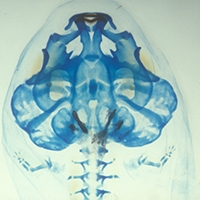Citation:
| 2.01 MB |
Date Published:
Mar 1Abstract:
Axolotls are poised to become the premiere model system for studying vertebrate appendage regeneration. However, very few molecular tools exist for studying crucial cell lineage relationships over regeneration or for robust and sustained misexpression of genetic elements to test their function. Furthermore, targeting specific cell types will be necessary to understand how regeneration of the diverse tissues within the limb is accomplished. We report that pseudotyped, replication-incompetent retroviruses can be used in axolotls to permanently express markers or genetic elements for functional study. These viruses, when modified by changing their coat protein, can infect axolotl cells only when they have been experimentally manipulated to express the receptor for that coat protein, thus allowing for the possibility of targeting specific cell types. Using viral vectors, we have found that progenitor populations for many different cell types within the blastema are present at all stages of limb regeneration, although their relative proportions change with time.
Notes:
089AKTimes Cited:5Cited References Count:40






